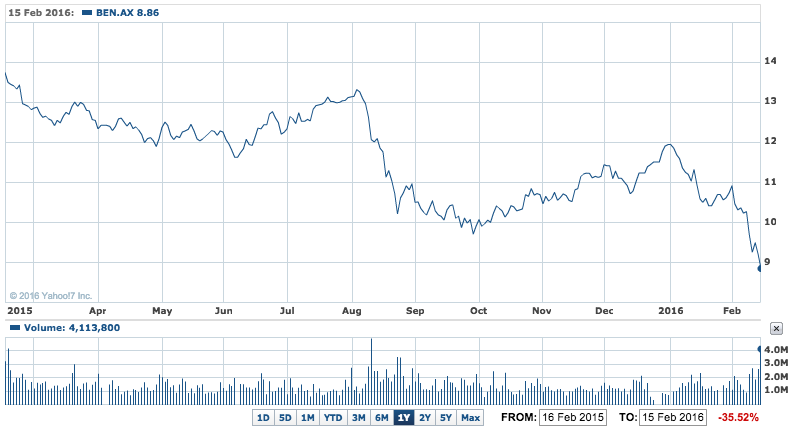Bendigo and Adelaide Bank (BEN) will pay a fully franked interim dividend of 34 cents a share, up one cent from the first half of 2014-15 after reporting a modest 2.7% rise in cash earnings yesterday to $233.7 million.
Net profit dipped 8.2% to $208.7 million and the bank reported a fall in its net interest margin and lower impairments – two points that worried analysts.
Revenue fell 0.6% to $781.6 million in the six months.
So the market wasn’t too impressed the shares were softer in yesterday’s trading after the news was released before trading started.
Bendigo’s shares fell 4% to $8.86, adding to the recent weakness that has seen the share price fall 22% from a high of $11.95. That fall is now 26%.
BEN 1Y – Weaker margins hurt Bendigo

The fall though isn’t confined to Bendigo exclusively – all the banks have been sold off in tune with the sell-off in Europe, Asia and the US as central banks push through more expansion spending, and now negative interest rates in more major economies. More and more investors are starting to question if bank earnings will be as reliable in future years as they have been, hence the recent sell-down in the sector.
CEO Mike Hirst said yesterday that mortgage competition increased to “irrational” levels in the first half, hitting its net interest income in the half year which dipped 0.8% to 2.16 cents in the dollar, or a fall of 3.6% (but still a few points higher than the Commonwealth though).
“This last half saw extreme price competition for mortgages, with several competitors seeking to increase their balance sheet exposure to Australian home loans and some irrational pricing in the lead up to changes in regulation,” Mr Hirst said in a statement yesterday. But he added that repricing of the mortgage market to more realistic levels has seen margin improve in the latter part of the half.
Mr Hirst said more customers also took advantage of low rates to overpay their home loans, reducing interest payments to the bank and about 43% of Bendigo’s customers are ahead in their loan repayments, while the number of mortgage offset accounts rose 12% in the half year.
Mr Hirst also said that around 81% of the bank’s funding is now provided by retail customers (compared to 64% at the Commonwealth).
“All of this means that the bank is in a very strong position from a balance sheet perspective and particularly well placed to compete vigorously for customers in the future,” Mr Hirst said.













